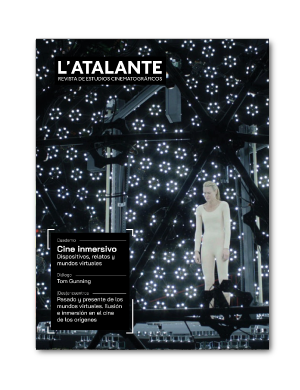Tipologías no narrativas: el modelo hermético-metafórico y la cinematografía de atracciones unidos por la experiencia estética
Publicado 01.01.2023
Palabras clave
- Teoría del cine,
- Estética del cine,
- Historia del cine,
- Lenguaje cinematográfico,
- Modelos de representación
- Cinematografía de atracciones,
- Modelo hermético-metafórico ...Más
Cómo citar
Resumen
Desde su nacimiento, el medio cinematográfico ha demostrado tener un lenguaje propio que ha cambiado mediante el desarrollo de nuevas técnicas y corrientes artísticas. Está, por eso, en constante evolución, tanto en el ritmo narrativo como en el propio significado de las imágenes. Bajo esta perspectiva, el presente artículo pretende vislumbrar las principales diferencias entre los modos de representación, partiendo de la clásica distinción entre cine narrativo y no narrativo, para subrayar los elementos compartidos por algunos fenómenos audiovisuales que suspenden la narración. Así, se analiza el modelo hermético-metafórico, desarrollado por Sánchez-Biosca para describir el modelo expresionista-caligarista, relacionándolo con el considerado cine de atracciones, término acuñado por Tom Gunning. Teniendo en cuenta que se trata de fenómenos diferentes en forma y contexto, se observan algunas confluencias entre ellos, llegando a la conclusión de que los planos hermético-metafóricos pueden confluir con la atracción en la experiencia estética, donde el shock causado por un nuevo efecto técnico y especial coincide con el que provoca un elemento visual y estilístico, como pueden ser las referencias continuas a la pintura o la muestra de decorados siniestros.
Descargas
Citas
Aumont, J., Bergala, A., Marie, M. y Vernet, M. (1985). <em>Estética del cine: espacio fílmico, montaje, narración, lenguaje</em>. Barcelona: Paidós.<br>
Barnier, M. y Kitsopanidou, K. (2015). <em>Le cinema 3-D. Histoire, économie, technique, esthétique</em>. Paris: Armand Collin.<br>
Bazin, A. (2021). <em>¿Qué es el cine?</em>. Madrid: Rialp.<br>
Burch, N. (1987). <em>El tragaluz del infinito</em>. Madrid: Cátedra.<br>
Eisenstein, S. (2004). El montaje de atracciones. En J. Romaguera i Ramió, T. Homero Alsina (eds.), <em>Textos y manifiestos del cine. Estética. Escuelas. Movimiento. Disciplinas. Innovaciones</em>, Signo e imagen (pp. 72-75), Madrid: Cátedra.<br>
Eisner, L. H. (1988). <em>La pantalla demoniaca</em>. Madrid: Cátedra.<br>
Elseasser, T. (2011). Reexaminando el cine de atracciones: cambios epistémicos, realineamientos diegéticos y el retorno de Rube en los medios digitales. <em>Revista Imagofagia – Asociación Argentina de Estudios de Cine y Audiovisual</em>, <em>3</em>, 1-31. Recuperado de http://www.asaeca.org/imagofagia/index.php/imagofagia/article/view/748. <br>
García, S. (10 de noviembre de 2013). Expresionismo alemán. <em>Historia del cine. </em>Recuperado de https://historiadelcine2.webnode.es/en-alemania-/expresionismo-aleman/. <br>
Gaudreault, A. (2007). Del “cine primitivo” a la “cinematografía-atracción”. <em>Secuencias: Revista de historia del cine</em>, <em>26</em>, 10-28. Recuperado de https://repositorio.uam.es/handle/10486/3936.<br>
Gómez Tarín, J. (2004). Tres procedimientos discursivos en las cinematografías del cambio de siglo. En N. Mínguez Arranz, N. Villagra García (eds.). <em>La comunicación: nuevos discursos y perspectivas</em> (pp. 191-198). Madrid: Edipo.<br>
Gubern, R. (2005). <em>Del bisonte a la realidad virtual: La escena y el laberinto</em>. Barcelona: Anagrama.<br>
Gubern, R. (2016). <em>Historia del cine</em>. Barcelona: Anagrama.<br>
Gunning, T. (2006). The Cinema of Attraction[s]: Early Film, Its Spectator and the Avant-Garde. En W. Strauven (ed.), <em>The Cinema of Attractions Reloaded</em> (pp. 381–388). Amsterdam: Amsterdam University Press.<br>
Jiménez González, M. (2022). <em>Fritz Lang y el expresionismo</em>. Valencia: Shangrila.<br>
Kant, I. (1999). <em>La crítica del juicio</em>, Madrid: Austral.<br>
Kurtz, R. (2016). <em>Expressionismus and Film</em>. Indiana: Indiana University Press.<br>
Lacasa, A. (5 de octubre de 2010). El cine de atracciones. <em>Alberto Lacasa Audiovisual, política y más allá</em>. Recuperado de https://albertolacasa.es/el-cine-de-atracciones/ <br>
Lang, F. (1995). The Future of the Feature Film in Germany. En A, Kaes, M. Jay, E. Dimendberg (eds.). <em>The Weimar Republic Sourcebook</em>. (pp. 622-623). Los Angeles: University of California Press.<br>
López Iglesias, J. (2016, 21 de septiembre). Jordi Balló: «El cine es el arte central del siglo XX». <em>HoyEsArte</em>. Recuperado de https://www.hoyesarte.com/cine/jordi-ballo-el-cine-es-el-arte-central-del-siglo-xx_231885/ <br>
Marzal Felici, J. J. (1999). Espectáculo y atracción fílmica: la mirada cautiva del cine de acción contemporáneo. En V. J. Benet, E. Nos (eds.). Cuerpos en serie, Estudis sobre la traducció, 6, (pp. 57-76). Valencia: Universitat Jaume I.<br>
Mitry, J. (1986). <em>Estética y Psicología del cine 2. Las formas</em>. Madrid: Siglo XXI Editores.<br>
Quiñones Triana, Y. (2013). El cine en 3D. Lo hiperreal como una forma de superación del plano bidimensional de representación de la realidad y el ecosistema del nuevo tipo de público: el cíborg virtual. <em>Revista Imagofagia – Asociación Argentina de Estudios de Cine y Audiovisual</em>, 8, 1-30. Recuperado de https://dialnet.unirioja.es/servlet/articulo?codigo=7299988 <br>
Sánchez-Biosca, V. (1985a). <em>Teoría del montaje en el film mudo de la República de Weimar. </em>Tesis doctoral. Valencia: Universidad Literaria de Valencia.<br>
Sánchez-Biosca, V. (1985b). Vanguardismo y problemática del filme alemán de la República de Weimar. <em>Contracampo revista de cine</em>, <em>38</em>, 84-97. Recuperado de https://roderic.uv.es/bitstream/handle/10550/30100/060934.pdf?sequence=1&isAllowed=y <br>
Sánchez-Biosca, V. (1990). <em>Sombras de Weimar. Contribución a la historia del cine alemán 1918-1933</em>. Madrid: Verdoux.<br>
Sánchez-Biosca, V. (1991). <em>Teoría del montaje cinematográfico</em>. Valencia: Filmoteca de la Generalitat valenciana.<br>
Strauven, W. (2006). Introduction to an Attractive Concept. En W. Strauven (ed.), <em>The Cinema of Attractions Reloaded</em> (pp. 11–28). Amsterdam: Amsterdam University Press.<br>
Truffaut, F. (2010). <em>El cine según Hitchcock</em>. Madrid: Alianza editorial.</p>

